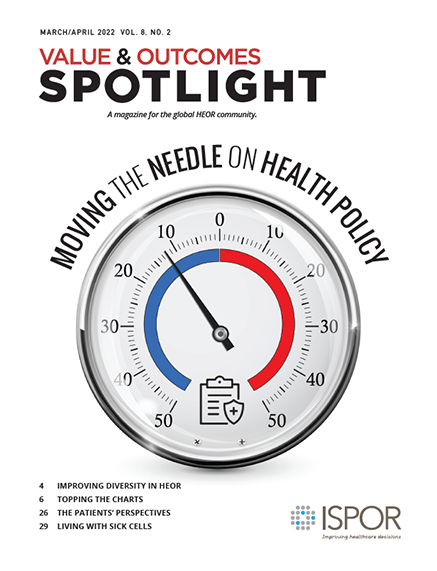Building Up What’s Breaking Down: HTA in Latin America
Section Editor: Marisa Santos, PhD, MD, Instituto Nacional de Cardiologia, Rio de Janeiro, Brazil
I spoke with Vania Canuto, Director, Department of Management of Technology Incorporation and Innovation in Health, National Committee for Health Technology Incorporation (CONITEC), about some of the biggest obstacles to the implementation of health technology assessment in Latin America. Canuto has been working with the Brazilian Ministry of Health for more than 10 years.
 VOS: What do you believe are the most significant obstacles to health technology assessment (HTA) implementation in Latin America’s low- and middle-income countries?
VOS: What do you believe are the most significant obstacles to health technology assessment (HTA) implementation in Latin America’s low- and middle-income countries?
VC: The existence of health policies that encourage the decision-making process based on evidence is the first step towards the implementation of HTA in the country. In this sense, it is necessary to broaden the debate on the subject in Latin American countries. All actors involved need to be aware of the important role of HTA as a tool for the efficient use of health resources and to promote access to more effective technologies that are adequate to the real needs of patients.
In this sense, in 2008, the Brazilian Ministry of Health created the Brazilian Health Technology Assessment Network, which has made substantial efforts to contribute to the formation of Health Technology Assessment Centers. These centers seek to introduce the HTA culture in universities, hospitals, and other public health establishments. In this regard, we can highlight the work of the Red de Evaluación de Tecnologías Sanitarias de las Américas in order to bring together actors and stimulate the debate and implementation of HTA in Latin American countries.
But undoubtedly, in addition to the underfunding of health systems, one of the biggest obstacles to the implementation of HTA in Latin America is the shortage of trained professionals. Both the Brazilian Health Technology Assessment Network and the Red de Evaluación de Tecnologías Sanitarias de las Américas have promoted and fostered training in the area, but the need for qualified labor still persists.
In the United States, HTA has been used by some health insurance companies and large hospitals for a long time, despite not having a public health system. However, HTA has less space in a market-oriented health system where the consumer/patient pays directly for a given health technology.
VOS: Have health policies changed in the past 5 years?
The first, Law no. 14,307, passed on March 3, 2022, introduced the use of HTA and the predictability of deadlines in the process of updating coverage in the field of private health, and instituted the Commission for Updating the List of Procedures and Events in Supplementary Health.
The second was the approval by the national Congress of a bill that determines that the methodologies, indicators, and cost-effectiveness parameters used in the economic evaluation of the process of analyzing the incorporation of technologies in the Sistema Único de Saúde by the National Committee for Health Technology Incorporation be set out in regulation and widely disseminated.
It is imperative to implement decision-making systems duly supported by scientific and economic evidence, whose results are investigated and analyzed using consistent methodologies.”
VOS: Is universal health coverage gaining or losing ground in the governments of the Americas?
VC: During the pandemic we observed the appreciation of the Sistema Único de Saúde, our public health system, by the Brazilian population and a significant expansion of the debate around public health and the guarantee of universal access to healthcare. Successful healthcare systems such as the United Kingdom and Canada show that the universal public system is more rational and efficient. In this sense, researchers and management bodies have been dedicated to improving decision-making processes and seeking to promote evidence-based health policies that actually meet the needs of users. In addition, we see the expansion of dialogue between countries in order to create strategies that address territorial needs and also the creation of manuals and guidelines for good practices in HTA, in addition to the exchange of experiences and knowledge between Latin American countries.
VOS: How can we create a sustainable health system with premium prices for rare diseases?
VC: This is undoubtedly an important challenge, especially in the context of health systems with limited funding, as is the case in most Latin American countries. We have observed a significant increase in the prices of new technologies for these diseases and the available studies do not allow us to be sure of the real benefit they will bring to the patient. It is increasingly essential to assess the opportunity cost and the impacts that high prices can produce in a health system with such limited resources. Given this, 2 actions do not fully resolve the issue but can help to mitigate it. On the one hand it is important that the technologies incorporated for rare diseases have their effectiveness evaluated through information systems and real-world studies, given the disruptive nature these technologies and the innovations that have been increasingly present. On the other hand, measures such as risk-sharing agreements can also prove to be a potent alternative. In any case, the central effort must be to offer the population the most effective therapeutic alternative, without the inappropriate use or investment of public resources in less efficient technologies than others.
"In addition to the underfunding of health systems, one of the biggest obstacles to the implementation of HTA in Latin America is the shortage of trained professionals."
VOS: How do you view the Latin American countries’ fragmented health systems?
VOS: What can we do as HEOR researchers to make an impact on healthcare policy at a local, regional, or national level?
VC: It seems to me to be of fundamental importance that researchers dedicated to economics and health outcomes are in close contact with managers and public health policy bodies at the local, regional, and national levels. It is imperative to implement decision-making systems duly supported by scientific (quantitative and qualitative) and economic evidence, whose results are, in turn, investigated and analyzed using consistent methodologies. With this, it is possible to establish a virtuous cycle of creation, evaluation, and improvement of public health policies that accompany the technical-scientific development in the area.

